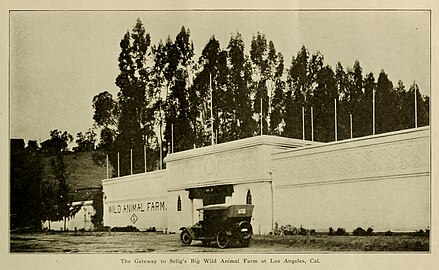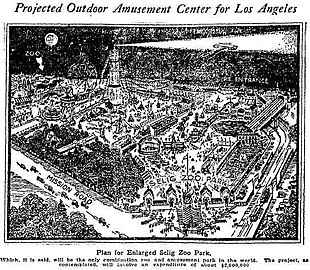Selig Zoo
| Selig Zoo | |
|---|---|
 Selig Zoo archway, 1955 | |
 | |
| 34°04′03″N 118°12′03″W / 34.0676°N 118.2009°W | |
| Date opened | 1915 |
| Date closed | c. 1940 |
| Location | 3800 Mission Road, Lincoln Park, Los Angeles, California |
The Selig Zoo in Los Angeles, California was an early 20th century animal collection managed by
History
According to Haenni, "Selig became the owner of
The public opening day of the zoo was June 20, 1915.[6] As of September 1915, the Selig Zoo housed over 700 animals including two giraffes (named Fritz and Leni[1]), nine lions, sacred cows from India, llamas from Peru, and an unidentified species of "temple monkey."[7] Elephant performer Toddles came to Selig from Big Otto by way of Ringling.[8] The head zookeeper was John Robinson.[7] The Selig Zoo held a five-year-old orangutan called Prince Chang.[9][10] He supposedly lived in a castle with a southern exposure and its own garden;[10] his enclosure was said to be electrically heated.[11] He appeared in a one-reel Selig film called The Orang-Outang.[12] Described as "enormous," Chang did not immediately take to the rigors of film production. He reportedly chased costar George Larkin around the studio while brandishing a cane, and wrecked two sets. Eventually, furniture made of cast iron bolted to the floor allowed production to continue.[13]
Two of the keepers at the Selig Zoo were brothers Clarence and Melvin Koontz, the latter of whom went on to a long career as an animal trainer.[14] A noted historian of American circuses and circus elephants, Chang Reynolds, worked at the Selig Zoo as a young man.[15]
In 1917 Selig sold the Edendale production facility to William Fox and moved Selig Polyscope to the zoo in East Los Angeles. Meanwhile, World War I cut severely into the substantial European revenues Selig Polyscope had been garnering, and the company shunned profitable movie industry trends, which had shifted towards dramatic (and more costly) full length feature films. Selig Polyscope became insolvent and ceased operations in 1918.
Movie studios rented animals and staged many shoots at the Selig zoo (sometimes later claiming they had been filmed in
Selig planned to develop the property into a major tourist attraction,
In 1925 a guidebook outlined the attractions for tourists:[18]
On entering, the visitor proceeds first to the Lion House, a low, quadrangular structure in Mission style, with the cages facing inward upon an arcade surrounding a central patio. There are 44 of these cages, containing lions, leopards and monkeys.
Proceeding S., we reach (on R.) a row of outdoor cages containing various birds and animals. Beyond are nine enclosures containing a large collection of pheasants, including some interesting hybrids. Oppo site are the Bear Dens, also a few smaller animals.
Further N. (on R.) are various birds. Opposite are the Ostrich pens. Behind the latter is the Elephant House.
Nearby is a circular Training Cage, where the process of training young lions and tigers for use in e may often be seen in the morning, and where Animal Acts are given Saturdays and Sundays at 3 o'clock .
Returning to entrance by E. path, we pass a group of cages containing a numerous assortment of Storks and Cranes.

The zoo was in operation until about 1935.
The carousel survived on the site until 1976 when it was destroyed by fire. The former Selig Zoo's arched front gate with its lavish animal sculptures was a crumbling landmark in Lincoln Heights for many decades. By 2003 the sculptures were reportedly being restored for installation at the Los Angeles Zoo and in 2007 tennis courts were on the site.[23]
Gallery
-
Selig's Wild Animal Farm 1911ish to 1914ish somewhere in Santa Monica near a streetcar line
-
Animal collection highlights, 1915
-
Promotional drawing for the planned Selig Zoo Park in East LA, with light rail connections, cars speeding towards the entrance and long lines depicted at the gate. Only a single carousel was ever built and the site struggled as a lightly visited zoo for over a decade.
-
Asian elephant at the Selig Zoo, c. 1920
-
Selig Zoo and environs in Baist's Real Estate Atlas, 1921
See also
- Cawston Ostrich Farm – Los Angeles tourist attraction (1886–1935)
- Gay's Lion Farm – Tourist attraction in El Monte, California, United States (1925–1942)
- Catalina Bird Park – Aviary on Catalina Island, California (1926–1966)
- Feather Hill Zoo – Animal collection, Santa Barbara, California (1924–1930)
- Universal City Zoo – Animal collection in California (1913–1930)
- Jungleland USA – Defunct private zoo, animal training facility, and theme park
References
- ^ ISBN 978-1-137-54342-4. Retrieved 2023-02-15.
- ISBN 978-0-8108-2722-6.
- ^ "Motography (Apr-Dec 1911) - Lantern". lantern.mediahist.org. Retrieved 2023-02-16.
- ^ "Maintaining a Wild Animal Jungle for Pictures, The Diamond S Farm, Motography (Jan-Dec 1912) - Lantern". lantern.mediahist.org. Retrieved 2023-02-16.
- ^ "Moving Picture World (Jul-Sep 1915) - Lantern". lantern.mediahist.org. Retrieved 2023-02-16.
- ^ The Movie Magazine: A National Motion Picture Magazine ... Movie Magazine Publishing Company, Incorporated. 1915. p. 24.
- ^ The Los Angeles Times. September 5, 1915. p. 13. Retrieved 2023-02-15 – via Newspapers.com.
- ^ "Altoona Times 05 Jun 1913, page 12". Newspapers.com. Retrieved 2023-02-16.
- Moving Picture World. Vol. 25, no. 7. August 14, 1915. p. 1144. Retrieved 2022-11-25 – via Media History Digital Library.
- ^ a b "Chang's Throne Totters". The San Francisco Call. Vol. 97, no. 154. June 26, 1915. p. 9. Retrieved 2022-11-25 – via California Digital Newspaper Collection.
- Moving Picture World. Vol. 25, no. 2. pp. 227–229. Retrieved 2022-11-25 – via Media History Digital Library.
- Moving Picture World. Vol. 25, no. 6. August 7, 1915. p. 1095. Retrieved 2022-11-25 – via Media History Digital Library.
- ^ "A Wild Animal Film". The Bioscope. Vol. xxviii, no. 461. London. August 12, 1915. p. 655. Retrieved 2022-12-04 – via British Newspaper Archive.
- ^ Buck, Frank; Weld, Carol (1939). Animals are like that. New York: R.M. McBride and Co.
- OCLC 1352405.
- ^ The Golden West. C.E. Stokes. September 1920. p. 9.
- JSTOR 1363221.
- ^ Rider, Fremont; Cooper, Frederic Taber (1925). Rider's California; a guide-book for travelers, with 28 maps and plans. New York: The Macmillan company: London, G. Allen & Unwin, ltd.
- ISBN 978-1-62584-682-2.
- ISBN 978-0-7385-2073-5.
- ^ Sutherland, Henry. "Services Set Monday for Olga Celeste: OLGA CELESTE." Los Angeles Times, Sep 04, 1969, pp. 2-c1. ProQuest, magic number 156299655
- ^ "Los Angeles Times: Lionesses on archway of entrance to the Selig Zoo". UCLA Digital Library. Retrieved 2018-06-21.
- ^ Hall, Carla (May 14, 2009). "Zoo to display lion statues from early L.A. menagerie". LA Times. Retrieved 2018-06-21.





